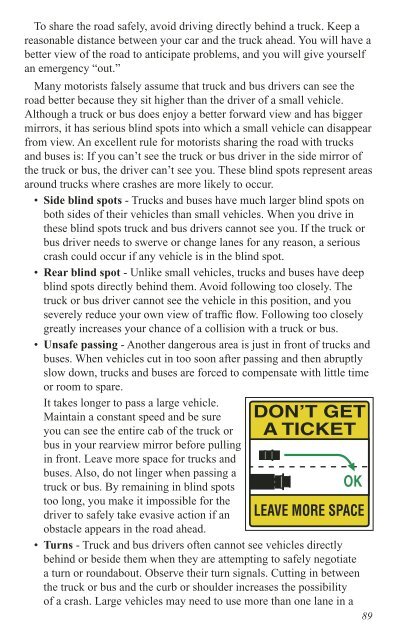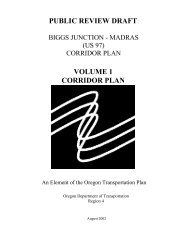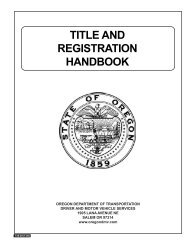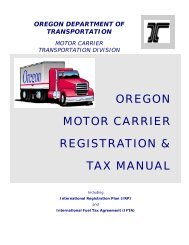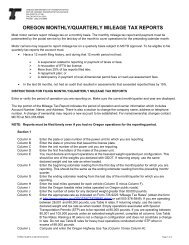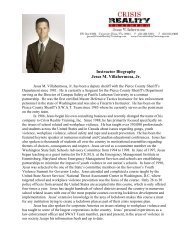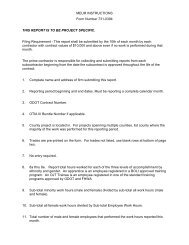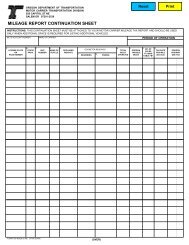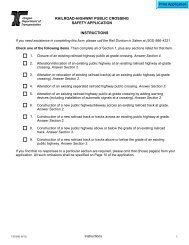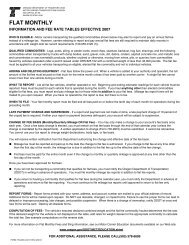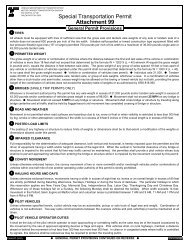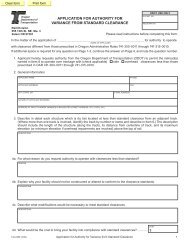2013 Oregon Driver Manual - Oregon Department of Transportation
2013 Oregon Driver Manual - Oregon Department of Transportation
2013 Oregon Driver Manual - Oregon Department of Transportation
Create successful ePaper yourself
Turn your PDF publications into a flip-book with our unique Google optimized e-Paper software.
To share the road safely, avoid driving directly behind a truck. Keep a<br />
reasonable distance between your car and the truck ahead. You will have a<br />
better view <strong>of</strong> the road to anticipate problems, and you will give yourself<br />
an emergency “out.”<br />
Many motorists falsely assume that truck and bus drivers can see the<br />
road better because they sit higher than the driver <strong>of</strong> a small vehicle.<br />
Although a truck or bus does enjoy a better forward view and has bigger<br />
mirrors, it has serious blind spots into which a small vehicle can disappear<br />
from view. An excellent rule for motorists sharing the road with trucks<br />
and buses is: If you can’t see the truck or bus driver in the side mirror <strong>of</strong><br />
the truck or bus, the driver can’t see you. These blind spots represent areas<br />
around trucks where crashes are more likely to occur.<br />
• Side blind spots - Trucks and buses have much larger blind spots on<br />
both sides <strong>of</strong> their vehicles than small vehicles. When you drive in<br />
these blind spots truck and bus drivers cannot see you. If the truck or<br />
bus driver needs to swerve or change lanes for any reason, a serious<br />
crash could occur if any vehicle is in the blind spot.<br />
• Rear blind spot - Unlike small vehicles, trucks and buses have deep<br />
blind spots directly behind them. Avoid following too closely. The<br />
truck or bus driver cannot see the vehicle in this position, and you<br />
severely reduce your own view <strong>of</strong> traffi c fl ow. Following too closely<br />
greatly increases your chance <strong>of</strong> a collision with a truck or bus.<br />
• Unsafe passing - Another dangerous area is just in front <strong>of</strong> trucks and<br />
buses. When vehicles cut in too soon after passing and then abruptly<br />
slow down, trucks and buses are forced to compensate with little time<br />
or room to spare.<br />
It takes longer to pass a large vehicle.<br />
Maintain a constant speed and be sure<br />
you can see the entire cab <strong>of</strong> the truck or<br />
bus in your rearview mirror before pulling<br />
in front. Leave more space for trucks and<br />
buses. Also, do not linger when passing a<br />
truck or bus. By remaining in blind spots<br />
OK<br />
too long, you make it impossible for the<br />
driver to safely take evasive action if an<br />
obstacle appears in the road ahead.<br />
• Turns - Truck and bus drivers <strong>of</strong>ten cannot see vehicles directly<br />
behind or beside them when they are attempting to safely negotiate<br />
a turn or roundabout. Observe their turn signals. Cutting in between<br />
the truck or bus and the curb or shoulder increases the possibility<br />
<strong>of</strong> a crash. Large vehicles may need to use more than one lane in a<br />
89


